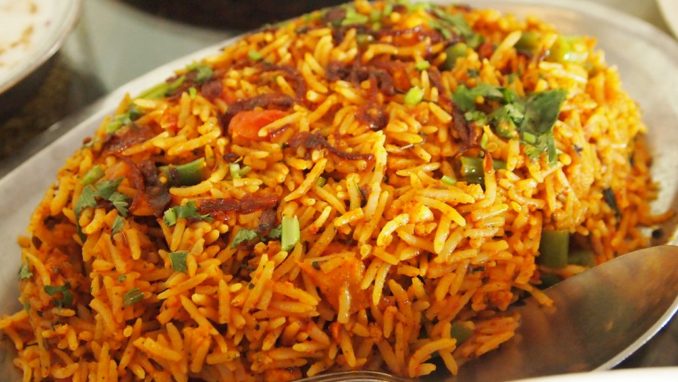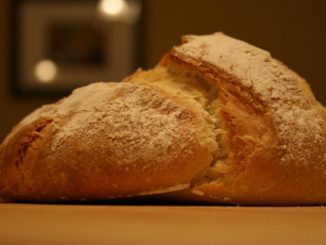
We are fortunate at chez Rookwood to offer our guests a wide variety of cuisine, everything from Scottish and English to Italian, French, German, Chinese and Indian. The latter is a bit of a misnomer however, as it can cover a multitude of variations including Persian and Pakistani. One of the most complex dishes is the Biryani, a luscious concoction of meat, vegetables, rice and yogurt. It is said that each grain of rice was coated with silver, indeed the food of kings. By far easier to screw up than to execute successfully, a good Biryani is a heavenly delight that is difficult to stop eating. Like a decent mixed meat couscous, the perfectly light balance of meat, stock and rice has a texture and mouth feel that is so moreish, you just cannot resist another forkful. Having cooked my best example to date, and using every ounce of self control not to go for my third helping, I can now share with you the secrets of turning out the perfect example. It has been hard won battle, and you are indeed honoured to share in my success, for I have cooked more completely crap examples than I’ll ever openly admit. That said, I can happily shuffle off this mortal coil in the knowledge I can now cook one of my favourite dishes at home rather than depending on the very variable local takeaway, something that was permanently, if not just subconsciously, on my bucket list.
This recipe will serve 4-6 people depending on appetite and sheer gluttony.
Trade secrets
It goes without saying it is not so much the recipe that makes the dish, but the technique and the ingredients. The only truly major stumbling blocks here is the rice, the way it is cooked and cooking in yogurt. It is essential you use a high quality, long grain basmati for this dish, I used Daawat extra long but any 1121 basmati will do. The cheaper basmati rice offerings just don’t cut it as I have found to my peril, they do not expand sufficiently and inevitably result in a stodgy, glutinous morass rather than perfectly separate grains. In reality, the rice needs to have sufficient plasticity to expand rapidly but not release any excess starch, the exact opposite of a risotto. For this you will need a high quality Basmati. Utensil wise, to cook this dish you will need a large, heavy based saucepan with a lid or a Dutch oven, a large Le Crueset casserole dish is ideal. It is also important that during the rice pre-cooking stage that the rice is cooked in sufficient water to float completely free, another reason for using as large a vessel as possible, just right but not too big. One of the keys to a decent Biryani is that you need to make a completely airtight seal for the final part of the rice cooking process, too large a pan would not be good idea either for smaller portions. This eliminates pots with a pouring spout, but you can still employ pans with a vent hole in the lid by covering pan itself with foil. You really do need a heavy pan for this to work though, cheap lightweight pans will just not hold enough heat. As the rice will be kept on a very low heat for 30 minutes, a gas ring is preferable. If you have an electric or induction cooker you might be better off using the oven on a low heat, say 120-140C, but I have not tried this method and you mileage may vary. Traditionally, the rice pot is placed on a low heat with a tawa (a shallow curved metal pan) used as a heat diffuser, so a sealed oven dish in the oven may be your best bet if you cannot guarantee a low, consistent heat sufficient to steam the rice without it drying out excessively or burning onto the bottom of the pan.
I have been very specific in the types of spices used, as the overall quality, taste and aroma of the dish is highly dependent on these. While I have taken a few liberties (e.g. the use of sultanas instead of bitter plums), for simplicity I have not included the more traditional esoteric varieties such as rose water, or indeed silver. While these are probably not available at your local Tesco, the others generally are or can easily be purchased online. If you are a regular curry chef there will be no problems with these ingredients, as they are frequently found in all varieties of Indian and Pakistani dishes. It goes without saying, the fresher the better, those spices that have been lying at the back of the cupboard for 5 years won’t cut it. I have a spice grinder, so I made my coriander and cumin powder from seeds, but I take my cooking adventures way too seriously.
Finally, a quick detour on the meat used and a discussion about “Lumpy bits”. I have used chicken breast here, whilst traditionally, bone in chicken thighs and / or legs are used, and often lamb or beef. To keep this recipe straightforward, I have omitted the traditional marinading of the meat and the use of ingredients that require extended cooking in yogurt. The reason is twofold, one, you can easily knock this up in a couple of hours from start to finish and secondly, you don’t run the risk of the yogurt separating into a grainy sludge. I have also gone against tradition and strained the whole masala from the rice cooking water, which removes the need for fishing out cloves etc. whilst eating. All of these are a matter of preference, but feel free to adapt the recipe to your own ends. If cooking with bone in chicken or red meat, I would use more tomato and possibly some stock to compensate for the extra cooking time, adding the yogurt well towards the end when the meat is fork tender or falling off the bone to avoid the risk of curdling. It is important that the cooked meat and onions is not swimming in sauce, as this will result in sodden, stodgy rice.
For those who have an aversion to fresh coriander, I personally can think of no other form of culinary torture as I absolutely adore the stuff. An adequate substitution would be fresh mint, but I will draw the line there. If you are allergic to nuts, just omit them. Unless you are a home curry fan, you will probably not have the dried methi leaves, but be wary of the fresh stuff which needs to be used sparingly or else it will totally overpower the dish. Methi adds a beautiful extra dimension, but it is not essential. Everything else is pretty much mandatory, miss them out and the dish will just not be the same.
I have used vegetable oil here as the equivalent amount of ghee is positively unhealthy. If you are offended by the amount of oil used, please reduce the amount, but one of the secrets to decent Indian food is the amount of oil, which not only adds flavour, but allows the spices to bloom in a way that a reduced amount would not. If you are using bone in meat, you can probably get away with less oil as the meat will release a lot of juices, and if they are skin on, fat too. Biryani is not diet food. It is no surprise that diet and low calorie foods have an abundance of other “Chemical goodies” to trick our taste-buds into enjoying them.
Measurements used are a standard UK coffee mug, approx 350ml, although to be perfectly honest I generally just eyeball them to get the ratios right.
Ingredients
- 4 large skinless boneless chicken breasts
- 1 mug natural yogurt (About 2/3rds a large carton)
- 3 large Spanish onions
- 1 large bulb of garlic
- Thumb sized chunk of fresh ginger
- 2 large fresh tomatoes
- 1 large potato (Any white variety)
- 3 mugs Basmati rice (Uncle Ben’s will not do here)
- 1 mug chopped fresh coriander
- 4 eggs
- 1 lemon
- 1/2 mug sultanas
- 1/2 mug flaked almonds
- 1/2 mug frozen petit pois
- 1/2 teaspoon of saffron
(Whole masala)
- 2 large Asian bay leafs (Tej patta)
- 6-8 inches of light brown cinnamon stick (Or 3-4 inches of Dalchini)
- 12 black peppercorns
- 6 green cardamom pods
- 2 black cardamom pods
- 6 cloves
- 1 star anise
- 1 heaped teaspoon of cumin seeds
(Powdered masala)
- 1 teaspoon turmeric
- 1 teaspoon good quality curry powder (Schwartz or East End)
- 1 teaspoon Kashmiri red chilli powder
- 1 teaspoon coriander powder
- 1 teaspoon cumin powder
- 1 teaspoon dried methi leaves
- 1 teaspoon garam masala
(Miscellaneous)
- Salt
- Vegetable oil (or ghee, not olive oil)
- Thick tinfoil to seal the cooking pan
- A heavy bottomed skillet or frying pan with lid
- A small saucepan with lid
- A large heavy bottomed saucepan with lid
- Colander or sieve
Mise en Place
Peel and finely slice the onions, preferably using a mandolin, and fry in 6 tablespoons of oil with a teaspoon of salt in a heavy skillet over a medium low heat until evenly golden brown and caramelised, stirring frequently (about 30-40 minutes). Meanwhile:
Measure the rice, rinse well and soak covered in cold water
Add the eggs to a pot of boiling water and boil covered for 6 minutes, cool, peel and dice into large chunks
Peel and crush the garlic
Peel and finely chop the ginger
Wash and finely chop the coriander reserving a little for decoration
Cut lemon into wedges (For decoration)
Peel and chop the potato into 2cm dice, rinse and cover with cold water
De-seed and de-pith the tomatoes, retaining the seeds and pith. Chop the remaining tomato into 1cm pieces and reserve separately
Dice the chicken into 2cm pieces
Add the saffron to 2 tablespoons of hot water or milk.
Method
In the pot you intend to cook the rice, add 6 tablespoons of oil, and heat until shimmering. Add the whole masala and a teaspoon of salt then stir fry for 30-60 seconds but do not allow to burn or singe. Carefully fill the pot with cold water and bring to the boil, reduce to a strong simmer and cover, topping up with cold water as necessary.
Once the onions have browned, remove to a side dish. Add 6 tablespoons of oil, and once hot, add the chicken, garlic, ginger and powdered masala, frying quickly over a medium-high heat. As soon as there is the slightest hint of catching or the chicken is starting to brown, add the tomato pith and seeds, the caramelised onions and a dash of water to deglaze the pan. Reduce the heat to low, and add just enough yogurt to well coat the chicken and the onion, and cover. We want just enough gravy to provide steam, but not so much that the rice will be over saturated. Cook for about 5 minutes, stirring occasionally, then add the drained potatoes, petit pois and sultanas and some more yogurt if required. Simmer very gently until the potatoes are still firm but easily pierced with the point of a knife and the chicken is easily split with a blunt spatula or side of a fork. Resist the temptation to bring to a boil, as the yogurt may burn or split.
Meanwhile, either drain the water with the whole masala into a bowl using a sieve, or use a draining spoon to remove the now softened masala from the liquid. Return the water to the pan if required, return to the boil, add the drained rice and boil, covered, for 6-8 minutes until the rice is al dente ensuring there is plenty of water for the rice to float free. Once you can split the rice with your fingernail and you can see a tiny small white circle in the centre of the rice, that is perfect. Drain the rice from the pot, cover and reserve.
Add about 1 tablespoon of oil to the pot, using a brush or or some kitchen roll, make sure there is a even film of oil on the sides and the bottom of the container. Return half the rice, covering the bottom of the pan, spreading out gently, but do not push down. Season with a good pinch of salt. Repeat with the chicken, and scatter half the coriander, the diced egg, remaining tomato and the almond flakes on top, once again lightly seasoning. Cover with the remaining rice, and as before, gently spreading and not pressing. Pour on the saffron with its liquid in a pattern of your choice, top with the remaining coriander, season, and cover the pan with a thin layer of aluminium foil. Place the lid securely and firmly on top, and press the foil into the sides of the pan so as an much of an airtight seal as humanly possible is achieved. Place on the lowest heat on your hob for 30 minutes.
Remove from heat, gently stir, serve with a sprinkling of coriander and a wedge of lemon.
Enjoy the dish of Mughal emperors.
© Rookwood 2021
The Goodnight Vienna Audio file



